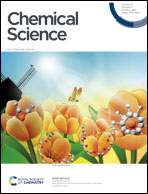A cyclopenta-fused dibenzo[b,d]thiophene-co-phenanthrene macrocyclic tetraradicaloid†
Abstract
A cyclopenta-fused macrocyclic tetraradicaloid, MC4-S, containing alternating phenanthrene (Phen) and dibenzo[b,d]thiophene (DBTh) units was synthesized and isolated in single-crystal form. Compared with its all-carbon isoelectronic structure, CPTP-M, the incorporation of two sulfur atoms leads to a smaller radical character and a larger singlet–triplet energy gap. X-ray crystallographic analysis reveals that the spin–spin coupling through the DBTh unit is stronger than that through the Phen moiety. In addition, the electron-rich sulfur atoms also raise the energies of both the HOMO and LUMO in MC4-S, but the overall optical and electronic energy gaps are close to that of the CPTP-M. MC4-S displays global anti-aromaticity according to the NMR measurements and theoretical calculations (NICS, ACID and 2D ICSS), with a 36π ring current circuit along the all-carbon periphery excluding the two sulphur atoms. Its dication becomes globally aromatic due to the existence of a dominant 34π-conjugation pathway. This study sheds some light on the effect of heteroatoms on the electronic properties of open-shell polyradicaloids.
![Graphical abstract: A cyclopenta-fused dibenzo[b,d]thiophene-co-phenanthrene macrocyclic tetraradicaloid](/en/Image/Get?imageInfo.ImageType=GA&imageInfo.ImageIdentifier.ManuscriptID=D0SC06185A&imageInfo.ImageIdentifier.Year=2021)


 Please wait while we load your content...
Please wait while we load your content...